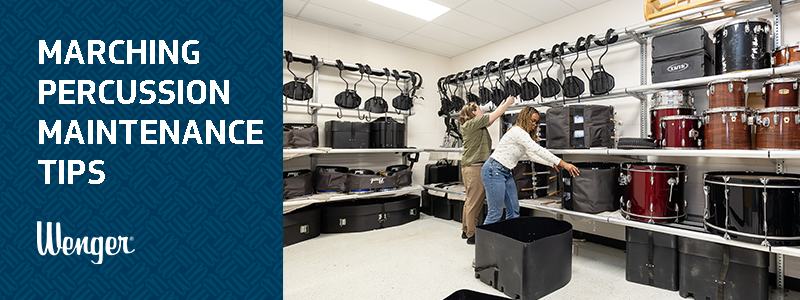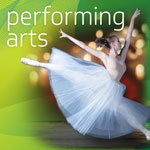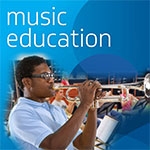Written by Wenger Guest Author Dr. Victoria Warnet, Assistant Professor of Music Education, Schwob School of Music, Columbus State University
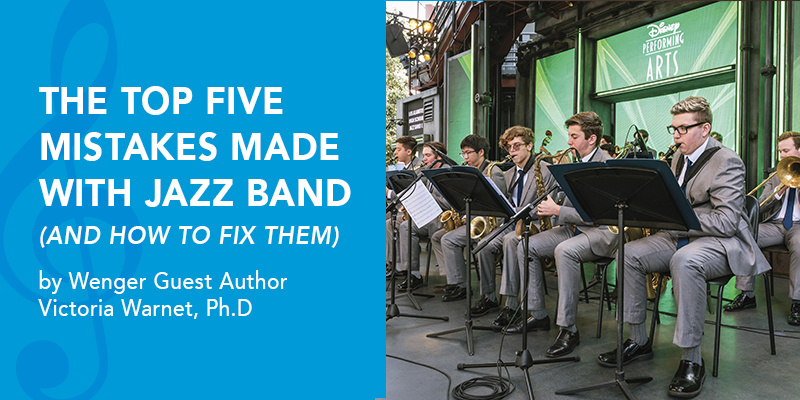
When I first began teaching, I felt I was most unprepared to teach jazz band. I would have benefited greatly from a “Jazz Band for Dummies” book or a list of common mistakes and suggestions for how to fix them; therefore, I attempted to make just that. I surveyed current jazz band clinicians, music performance assessment judges, and college professors to develop a list of the five most common problems they experience when working with or judging school jazz bands, as well as solutions to those problems.
1. IMPROVISATION
Improvisation is one of the most important aspects of jazz. It can, however, also be one of the most challenging concepts to teach. Students are sometimes afraid to play improvised solos for fear of sounding bad.
Solution 1:
Courage comes from practice.
Set students up for success in the way you approach improvisation. Incorporate improvisation into your warm-up. Call-and-response is a great way to get students to build their existing improvisation vocabulary (Watson, 2010). Rather than explaining improvisation as making something up on the spot, teach students to think about it as quickly applying their preexisting language. (After all, a conversation between two people involves improvisation in a linguistic sense! Sometimes students need to be reminded that they improvise every day with their language.) When teaching someone to improvise for the first time, start with a single note and simple rhythms. As students grow more comfortable with one note, give them another, slowly adding to their vocabulary. Explain to students how to use the chord changes to select which notes to play. A great way to improve improvisation skills is to have students listen to famous jazz musicians and try to imitate some of the solos they hear. Always make improvising a positive experience, especially in the early learning stages.
Solution 2:
Make sure you can hear the soloist.
A common problem in jazz bands is that the wind players or the rhythm section will often cover the soloist. Encourage the rhythm section to support the soloist by maintaining the energy and drive without playing over the soloist. If the soloist is playing quietly, the rhythm section should play softer. The wind players’ backgrounds should have the same effect; they should add to what the soloist is doing without covering the soloist.
2. PLAYING THE STYLE
Jazz bands often show up to music performance assessments playing accurate notes and rhythms, but they neglect to perform in the style of the piece (Tolson, 2012).
Solution 1:
Uniformity of syllables is essential for an ensemble to sound tight.
Be sure to assign all articulations syllables and have your students sing through their part on syllables to make sure they are all in agreement on note lengths and emphases. Standard articulation syllables are:
1) legato or tenuto as “Doo”; 2) staccato as “Dit”; 3) accents as “Dah”; and 4) marcato as “Daht”
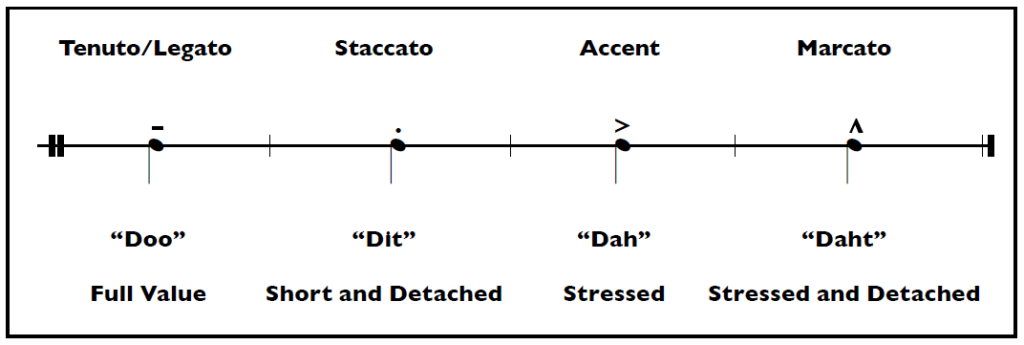
Solution 2:
Learn to swing.
Practice swing style by integrating swung eighth note patterns into the warm-up with students ghosting (playing softer or “swallowing”) the downbeats and emphasizing the upbeats. Eighth notes in swing style should have a triplet subdivision and be a quarter note/eighth note triplet rather than a dotted eighth/sixteenth note. Start by exaggerating the style at first. If needed, it will be easier to ask them to add emphasis later, rather than to take away emphasis.
Solution 3:
Study the history of jazz.
Get away from thinking of jazz as being either swing, Latin, funk, or a ballad. The history of a piece has a lot to do with the style in which it should be performed. For instance, an Ellington swing tune from the 1920s would not be performed in the same way a Parker swing tune from the 1940s would be performed. It is important for directors to identify which era of jazz the music represents, determine the performance standards used in that era, and then employ the correct standards in their pieces.
3. RHYTHM SECTION INTEGRATION
Often, rhythm section players come to jazz band with the mentality that they need to play exactly what is written on their part. Directors should instead encourage their rhythm section players to use their part as a guideline for the form and style of the tune, rather than a blueprint of exactly what they should play.
Solution 1:
Encourage the rhythm section members to get their eyes out of their music.
The members of the rhythm section need to be able to communicate with one another, which can be improved with frequent visual contact. Make sure that all of the rhythm section members have a direct line of sight with at least one or two other members. This is especially important with the piano, bass, and drum set players. Similar to concert band, when we encourage players to check the podium, the rhythm section members need to be able to see each other to groove together, move with the music, and make collaborative music, as opposed to simultaneous music. When players are able to see each other, they are able to both make and respond to musical decisions more easily and work together to make these choices rather than just playing the notes on the page. For the band to have a cohesive sound, the rhythm section needs to function as a supportive unit.
Solution 2:
Everyone needs to know their role.
The role of each instrument in the rhythm section can change depending on the style of the piece; however, here are some general guidelines (Zentz, 2010):
Piano: Play within the shoulders; stay away from lower bass notes. If the bass player is playing in that same range, it will muddy the sound. Make sure the piano player is reading and interpreting the chord symbols correctly and lining up their chord changes with the guitar player.
Guitar: Have the guitar player “chunk” on every beat with a heavier 2 and 4. The guitar player should aim for a “hollow-body” sound and keep all strokes quick and downward. The strings should not ring or vibrate afterward. The guitarist should be sure to line up their chord changes with the pianist.
Bass: The bassist is the foundation of time in a jazz ensemble. The bass player needs to pull the string and drive the tempo. The energy of the tempo comes from the string’s articulation. Many young bassists tend to set their amplifiers too bright; aim for a dark sound with enough high end to push the time. When learning how to construct a walking bassline, start with the blues.
Drum Set: Learn how to play in a variety of styles by listening to other great drum set players. Complement the bass player by feathering the bass drum instead of pounding on it. The drum set player is responsible for working with the bass player to set the style and tempo of the piece. Use set-up, kicks, and fills to lay out time for the wind players before they enter, and generate forward motion to ensure that the piece continues to spark enthusiasm and interest.
Auxiliary Percussion: Stay out of the way of the other rhythm section members and do not play anything too busy. When the vibes are used, make sure they are not being used in the same way the piano is being used. For instance, no two instruments should be comping at the same time. If the piano is comping, the vibes should not be.
4. JAZZ ENSEMBLE BALANCE AND BLEND
In concert bands, we are taught to balance and blend with the players around us. Students then come to jazz band and continue to play with their “concert band ears,” careful not to play louder than their neighbors. In jazz band, this should not be the case. Francis McBeth’s (1972) Pyramid of Balance and Blend is very different for jazz band (Zentz, 2010).
Solution 1:
Lead players need to lead.
The saxophones should never outplay the lead alto, just as the trombones should not outplay the lead trombone. The same rule applies to the trumpets; none should overplay the lead trumpet. Similarly, no one in the ensemble should outplay the lead trumpet when the lead trumpet has the melody. Likewise, the baritone saxophone and the bass trombone players should not be shy when playing below the staff.
Solution 2:
Everyone needs to listen in and listen back.
Everyone in the ensemble should listen back to the lead trumpet player for style and articulation. Often, a simple solution to fixing a jazz ensemble’s balance is simply to ask the trumpet players to take their bells out of the stand when they play so that the ensemble is able to listen back to them easily. For a model of this sound, directors can listen to any historically significant big band, such as the Count Basie Orchestra, Duke Ellington Orchestra, Fletcher Henderson Orchestra, or Jazz at Lincoln Center.
5. STUDENTS DO NOT LISTEN TO ENOUGH JAZZ
All of the surveyed professionals listed this problem somewhere on their list, with most placing it as their number one encountered problem. Many mentioned being surprised at the number of groups playing standard literature as if they have never heard it before.
Solution 1:
Have students listen to a lot of jazz regularly.
This includes both charts that they are playing in class as well as other quality jazz standards. Make listening a top priority with your jazz group (West, 2015). Create required listening assignments, have in-class discussion on the recordings, and encourage your students to subscribe to Apple Music, SmartMusic, or Spotify. If this is not possible, create a free Spotify or YouTube playlist, and share the link with your classes. There is no reason for students not to have access to quality music recordings.
Solution 2:
Program quality literature and expose your students to the standards.
Often, directors believe that because their students are not advanced players, they cannot play standard big band literature. There is a plethora of developing band literature, however, which consists of arrangements of standard big band tunes. The benefit of playing standards is that there are many reference recordings available for both directors’ and students’ use.

Victoria Warnet is the assistant professor of instrumental music education at Columbus State University. Dr. Warnet received her Ph.D. in Music Education from Florida State University in Tallahassee, Florida. Prior to her appointment at Columbus State University, Dr. Warnet taught band at Tavares Middle and High Schools in central Florida.
References
McBeth, W. F. (1972). Effective Performance of Band Music. San Antonio, TX: Southern Music.
Tolson, J. (2012). Jazz style and articulation: How to get your band or choir to swing. Music Educators Journal, 99(1), 80-86. doi:10.1177/0027432112449020
Watson, K. E. (2010). The effects of aural versus notated instructional materials on achieve-ment and self-efficacy in jazz improvisation. Journal of Research in Music Education, 58, 240-doi:10.1177/0022429410377115
West, C. (2015). What research reveals about school jazz education. Update: Applications of Research in Music Education, 33(2), 34-40. doi:10.1177/8755123314547825
Zentz, D. (2010). Top 10 Jazz Band Essentials from FMEA 2010 [PowerPoint slides]. Retrieved from http://www.zentz.org/dzlinks.html
This article was originally published in the August 2019 issue of Florida Music Director (Vol. 73, No. 1, pp. 10-13) and is being republished here with permission of the Florida Music Education Association.

